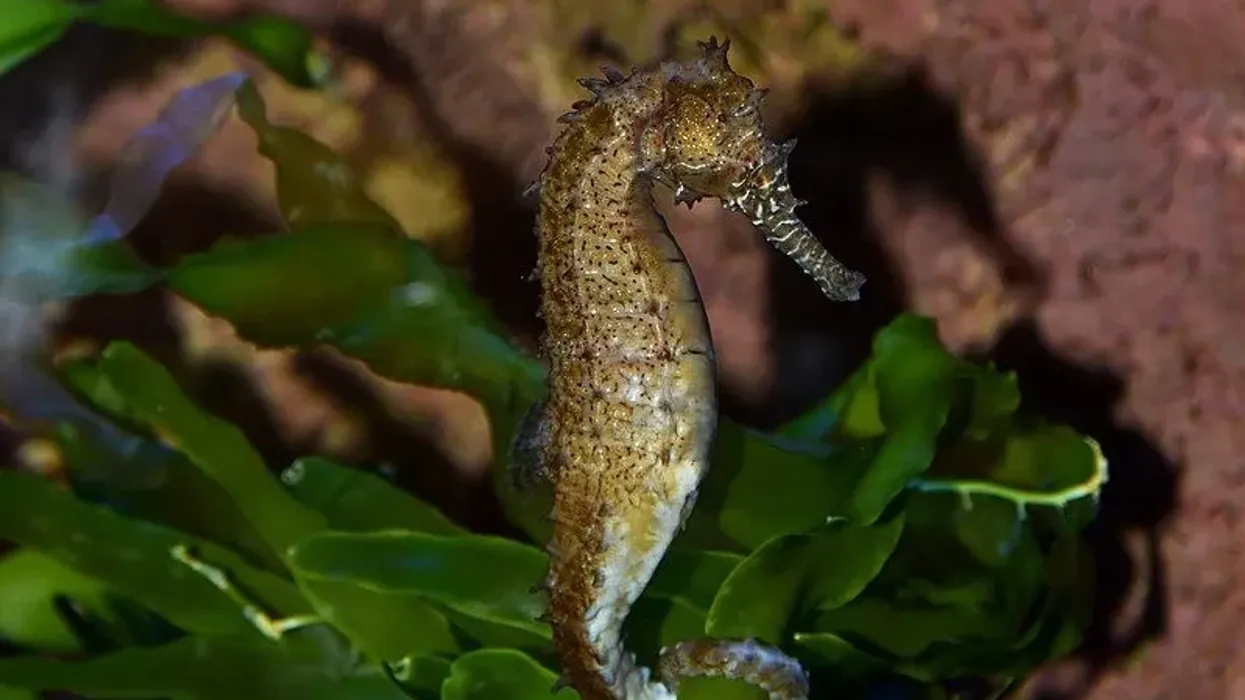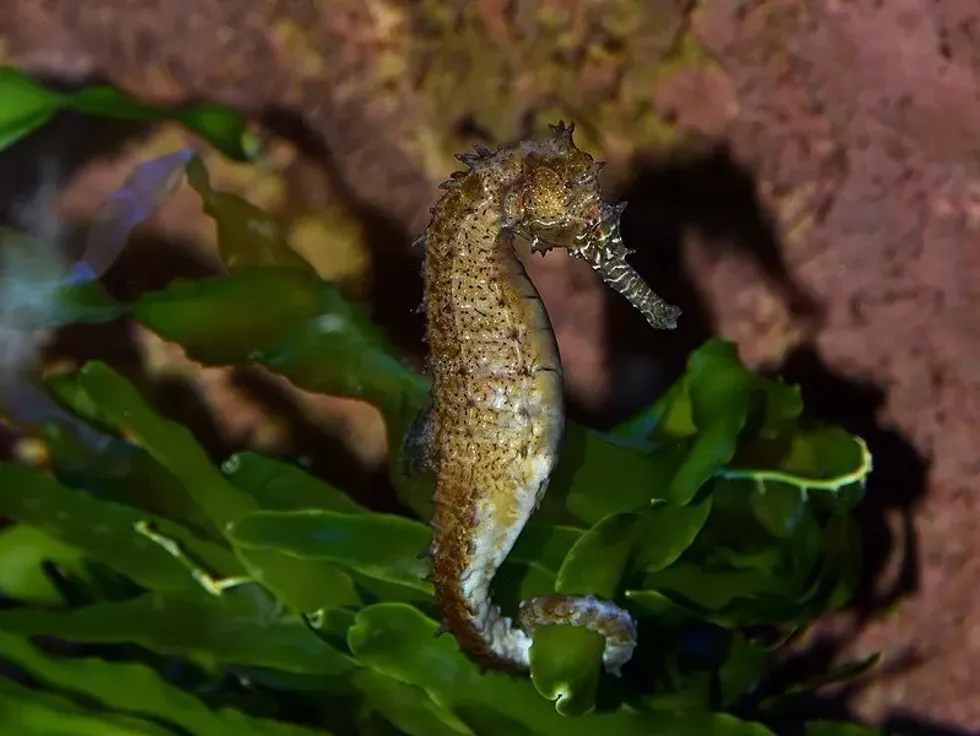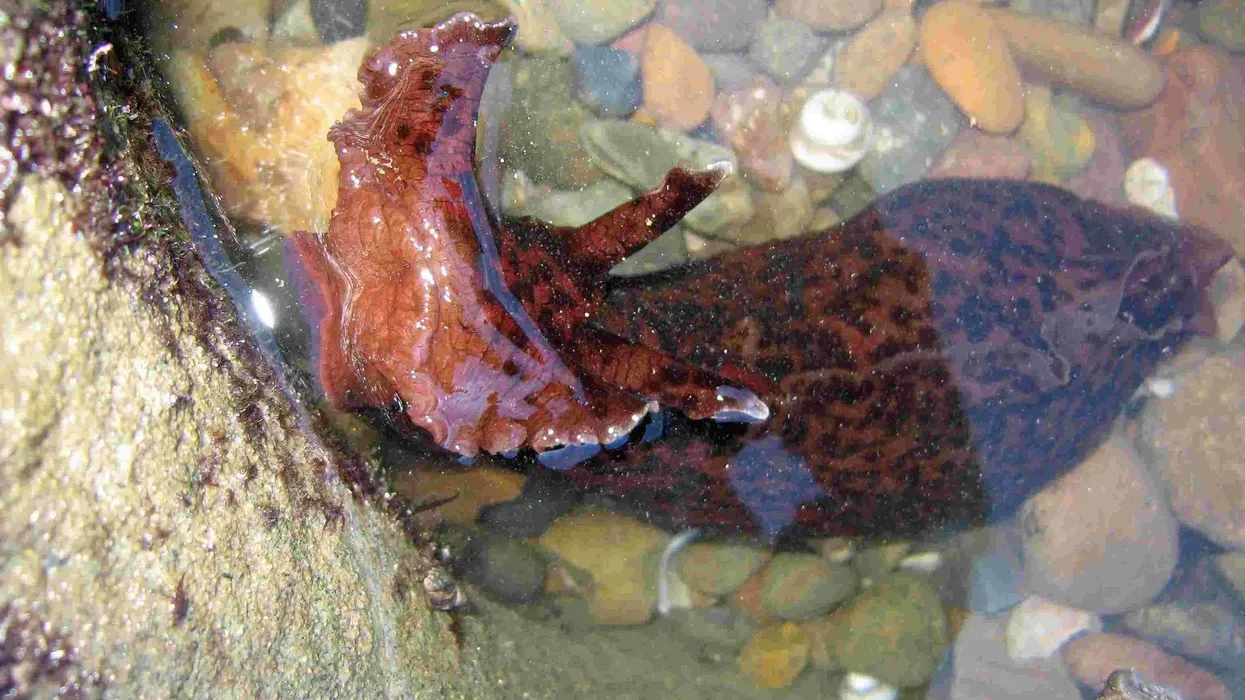The short-snouted seahorse is a water animal in the family Syngnathidae. It belongs to the genus Hippocampus. The short-snouted seahorse's scientific name is Hippocampus hippocampus. Its distribution range is from England to West Africa. It lives among the coastal regions of the Azores and Madeira.
Reproductive maturity is attained at the first period of the reproductive cycle. The clutch size of H. hippocampus is around 50-100 eggs. This seahorse has a titled head on the body with a long snout. This animal has the capability to hide in marine life.
The standard length of the H. hippocampus is 5.9 in (15 cm). It uses its tail to anchor itself to vegetation. It is a famous animal in the trade market because people love to keep it in an aquarium.
To know more about seahorses, you can also check out these tiger tail seahorse facts and Pacific seahorse facts.
Short-Snouted Seahorse Interesting Facts
What type of animal is a short-snouted seahorse?
The H. hippocampus is a marine seahorse species in the family Syngnathidae. It is a kind of fish, also known as pipefish and sea dragon.
What class of animal does a short-snouted seahorse belong to?
The H. hippocampus species belong to the class Actinopterygii and phylum Chordata. The genus of this animal is Hippocampus.
How many short-snouted seahorses are there in the world?
The population size of short-snouted seahorses is unknown.
Where does a short-snouted seahorse live?
The Hippocampus hippocampus is native to the south coast seas of England. Its populations are distributed around Ireland and the Channel Islands.
It is found in the northeast Atlantic, the Netherlands, south to Senegal, and the Mediterranean Sea. It is also found in the coastal waters of the Canary Islands, Azores, and Madeira.
The distribution is determined by the hotter waters of the Gulf Stream which provides the environment for higher productivity of plankton. It is the reason that the populations of this species exist in the North Sea and south of Great Britain.
The species also thrive in Italy, Europe, Algeria, Belgium, Netherlands, the east Atlantic coast of Europe, and Greece. In the year 2007, several colonies of Hippocampus seahorses had been found in Thames River, London.
What is a short-snouted seahorse's habitat?
The short-snouted seahorse habitat ranges from seagrass beds in shallow muddy water, estuaries, or offshore amongst seagrasses. This water animal can also be found in rocky regions. It is found at a maximum depth range of 252.62 ft (77 m) in the ocean.
H. hippocampus has a limited home range because of its very confined day-to-day actions. For instance, most of its motion occurs when a storm happens due to which it is carried away from one place to another.
In the winter it migrates into deeper water to flee stormy seas. Therefore, its distribution range is highly influenced by hotter waters. It can also be found in people's home aquariums.
Who does the short-snouted seahorse live with?
The young seahorses usually travel in small groups. When mature they find their mate for life and generally stay as a pair.
How long does a short-snouted seahorse live?
The lifespan of short-snouted seahorses (hippocampus) ranges between one and five years.
How do they reproduce?
Seahorses are monogamous animals that mate for life. They are ovoviviparous animals that exhibit true reversed pregnancy in which the females give their eggs to the males who self fertilizes them and keeps them in their small pouch called a brood pouch.
They pump water in and out of their brood pouch. The males give birth to many young ones known as fry.
The sexual maturity in fry comes in the first reproduction season after birth. The clutch size is from 50-100 young. The size of the mating season can range originally based on several water factors including light, temperature, and water turbulence.
There are two courtship behaviors in the seahorses. At first, the male jerks his snout at his opponent to move him away.
The second courtship behavior is wrestling which occurs when one male attempts to launch the opposing male. Interestingly, during the mating season, both males and females become brighter when greeting and courting one another.
What is their conservation status?
According to the IUCN, the H. hippocampus species is presently unlisted as it is Data Deficient. Earlier, it was listed as a Vulnerable species.
Many conservation activities are going on to save these animals. In the UK, there are two marine conservation zones assigned in seas of the Great Britain that were constructed to protect habitats and the population of hippocampus seahorses. The species is listed on the Convention on International Trade in Endangered Species of Wild Fauna and Flora Appendix II.
Seahorses are often caught as bycatch in seagrass habitats. These seahorses are used in various traditional Asian medicines and tens of millions of these marine creatures are traded each year.
Short-Snouted Seahorse Fun Facts
What does the short-snouted seahorse look like?

The Hippocampus hippocampus has a small upturned snout which is not more than one-third the length of the head. It has a distinctive body with its head slanted to the curved body. This animal has a curled, prehensile tail.
Unlike other seahorse species, H. hippocampus does not have a mane. It has light brown to mottled purple body color. The adult seahorse can reach up to a length of about 5.9 in (15 cm).
It possesses prominent spines above the eyes. There are 16-18 rays in the dorsal fin with a dark strip flowing parallel to the margin.
However, their pectoral fin has 13-15 rays. There are bony tubercles on the body rings which give a knobbly, angular appearance. The spines are very low in adults.
How cute are they?
Short-snouted seahorses are small, adorable marine creatures that are famous for the distinctive physical features that make them look undeniably cute.
How do they communicate?
H. hippocampus animals are non-verbal. Therefore, they communicate through different types of behaviors.
How big is a short-snouted seahorse?
The average short-snouted seahorse is 5.9 in (15 cm). They are similar to anchovies in size.
How fast can a short-snouted seahorse swim?
The swimming speed of the H. hippocampus is unknown. These creatures use their tail to cling onto seaweed or seagrass, as they are pretty poor swimmers.
How much does a short-snouted seahorse weigh?
The standard weight of H. hippocampus is 7 oz (198.44 g), which is 20 times smaller than a clownfish.
What are the male and female names of the species?
There are no specific names for male and female H.hippocampus.
What would you call a baby short-snouted seahorse?
The baby H. hippocampus is known as fry.
What do they eat?
The short-snouted seahorse's diet includes shrimp and plankton. On average, the adults will eat approximately 30-50 shrimp each day.
Are they dangerous?
Short-snouted seahorses are not dangerous animals. In fact, they are cute and lovable.
Would they make a good pet?
Yes, they are famous pets around the world. People love to keep them in an aquarium at home. They can be kept with tank mates like starfish, dartfish, and small cardinal fishes.
Did you know...
There is a stint crown known as a coral net which is different on every seahorse. It resembles the stripes of zebra which makes them unique from other seahorses. It is illegal to import or export dried seahorses in most countries.
What are some unusual characteristics of the seahorse?
H. hippocampus has the ability to camouflage itself.









